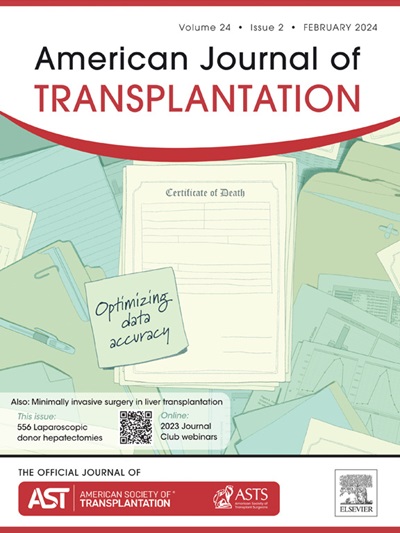Long-term outcomes of induction immunosuppression for kidney transplant recipients with HIV who have average immunologic risk: An inverse probability treatment weighting analysis
IF 8.9
2区 医学
Q1 SURGERY
引用次数: 0
Abstract
We analyzed the Scientific Registry of Transplant Recipients (2004-2022) for primary kidney transplant recipients with HIV who had average immunologic risk and were discharged on tacrolimus/mycophenolate mofetil (with or without corticosteroids). Recipients were grouped by induction type: rabbit antithymocyte globulin (r-ATG, n = 688) and human interleukin-2 receptor antagonist (IL2Ra, n = 467). Kaplan-Meier curves were generated to examine recipient and graft survival by induction type. We used mixed Cox proportional hazard models to determine associations between induction type and outcomes of interest, with adjustments for recipient and donor factors and transplant center as a random effect. Regression with propensity score weighting reduced selection bias from nonrandom induction allocation. The unadjusted 10-year survival rate was 57% for those receiving r-ATG and 64% for those receiving IL2Ra (P < .001). Adjusted risk of death was significantly lower for IL2Ra induction than r-ATG induction with Cox multivariable (hazard ratio, 0.65; 95% CI, 0.47-0.91; P = .01) and inverse probability treatment weighting (hazard ratio, 0.38; 95% CI, 0.29-0.50; P < .01) models. Death-censored kidney graft survival did not differ by induction type in either model. The 1-year rejection rate was 10.1% and 11.6% for r-ATG and IL2Ra recipients, respectively (P = .52). Overall, IL2Ra conferred better long-term survival than r-ATG without increased risk of graft loss.
免疫风险一般的 HIV 肾移植受者接受诱导免疫抑制的长期疗效:反概率治疗加权分析。
我们分析了《移植受者科学登记册》(2004-2022 年)中免疫风险处于平均水平、使用他克莫司/霉酚酸酯(含或不含皮质类固醇)出院的 HIV 初治肾脏受者。受者按诱导类型分组:兔抗胸腺细胞球蛋白(r-ATG,n=688)和人白细胞介素-2受体拮抗剂(IL2Ra,n=467)。我们根据诱导类型生成了卡普兰-梅耶曲线,以考察受体和移植物的存活率。我们使用混合 Cox 比例危险模型来确定诱导类型与相关结果之间的关系,并对受体和供体因素以及作为随机效应的移植中心进行了调整。倾向得分加权回归减少了非随机诱导分配带来的选择偏差。接受r-ATG诱导的患者未经调整的10年生存率为57%,接受IL2Ra诱导的患者为64%(P
本文章由计算机程序翻译,如有差异,请以英文原文为准。
求助全文
约1分钟内获得全文
求助全文
来源期刊
CiteScore
18.70
自引率
4.50%
发文量
346
审稿时长
26 days
期刊介绍:
The American Journal of Transplantation is a leading journal in the field of transplantation. It serves as a forum for debate and reassessment, an agent of change, and a major platform for promoting understanding, improving results, and advancing science. Published monthly, it provides an essential resource for researchers and clinicians worldwide.
The journal publishes original articles, case reports, invited reviews, letters to the editor, critical reviews, news features, consensus documents, and guidelines over 12 issues a year. It covers all major subject areas in transplantation, including thoracic (heart, lung), abdominal (kidney, liver, pancreas, islets), tissue and stem cell transplantation, organ and tissue donation and preservation, tissue injury, repair, inflammation, and aging, histocompatibility, drugs and pharmacology, graft survival, and prevention of graft dysfunction and failure. It also explores ethical and social issues in the field.

 求助内容:
求助内容: 应助结果提醒方式:
应助结果提醒方式:


